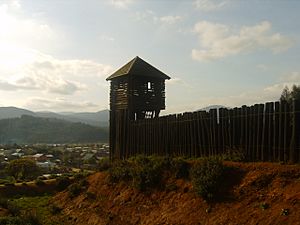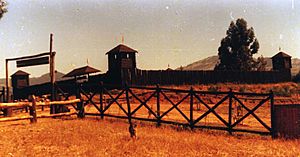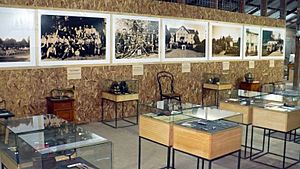Purén facts for kids
Quick facts for kids
Purén
|
|||||
|---|---|---|---|---|---|

Fort of Purén with the town in background
|
|||||
|
|||||
| Country | Chile | ||||
| Region | La Araucanía | ||||
| Province | Malleco | ||||
| Government | |||||
| • Type | Municipality | ||||
| Area | |||||
| • Total | 464.9 km2 (179.5 sq mi) | ||||
| Elevation | 88 m (289 ft) | ||||
| Population
(2012 Census)
|
|||||
| • Total | 11,815 | ||||
| • Density | 25.414/km2 (65.822/sq mi) | ||||
| • Urban | 7,604 | ||||
| • Rural | 5,264 | ||||
| Sex | |||||
| • Men | 6,408 | ||||
| • Women | 6,460 | ||||
| Time zone | UTC−4 (CLT) | ||||
| • Summer (DST) | UTC−3 (CLST) | ||||
| Area code(s) | country 56 + city 45 | ||||
Purén is a city and commune located in the Malleco Province of the La Araucanía Region in Chile. It sits at the western base of the Nahuelbuta mountain range, about 650 kilometers south of Santiago.
The main activities in Purén are forestry and farming. A special product from Purén is the white strawberry. This unique strawberry is one of the two types that were mixed to create the common garden strawberry we eat today!
In the Mapuche language, called Mapudungun, the word Purén means "swampy place."
Contents
Purén's History: Forts and Battles
The history of Purén is closely tied to its forts. These forts were important during conflicts between the Spanish and the native Mapuche people.
The First Fort: San Juan Bautista de Purén
The very first fort, called San Juan Bautista de Purén, was built by Juan Gomez de Almagro in 1558. This was ordered by the Governor of Chile, Pedro de Valdivia. It was located near the Purén River, a few kilometers from where the city is today.
After Pedro de Valdivia died, the fort was left empty. But it was taken over again by García Hurtado de Mendoza, 5th Marquis of Cañete in 1558. However, the Mapuche leader Guanoalca captured and burned it down in 1586.
Governor Alonso de Sotomayor rebuilt the fort in 1589. But the Mapuche kept attacking it. It was burned and abandoned again in 1598 during a big Mapuche uprising.
Forts Rebuilt and Abandoned
The fort was rebuilt several times over the years. Governor Alonso Garcia Ramon restored it in 1609. Then Governor Alonso de Ribera rebuilt it in 1613. But it was abandoned again in 1624.
It stayed empty until 1665, when Governor Francisco de Meneses Brito built another fort there. Finally, in 1723, Governor Gabriel Cano de Aponte decided to tear it down for good. The soldiers moved to a new fort called San Carlos de Purén, or "New Purén," near the Bio Bio River. The old fort's ruins were still visible in the 1890s.
Modern Purén Begins
A new fort was built in Purén on November 24, 1868. This fort was located a few kilometers from the old one. A village grew up next to this new fort in the 1890s, after the occupation of Araucania. This is how the modern city of Purén began.
Recently, some very old structures, like proto-pyramids or mounds, have been found near Purén. These show that people lived here long before the Spanish arrived.
Purén's Population
According to a 2002 study, Purén covers an area of 464.9 square kilometers. It had 12,868 people living there at that time. About 7,604 people (59.1%) lived in the city areas, and 5,264 people (40.9%) lived in the countryside. Between 1992 and 2002, the population of Purén decreased by about 7.5%.
How Purén is Governed
Purén is a "commune," which is like a local district in Chile. It is managed by a municipal council. The leader of the council is called an alcalde, who is like a mayor. The alcalde is chosen by the people every four years. The alcalde from 2008 to 2012 was Benigno Quiñones Lara.
See also
 In Spanish: Purén para niños
In Spanish: Purén para niños






